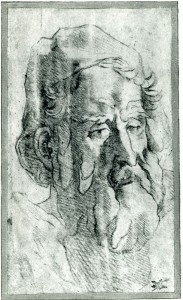Study for the Head of St. Anthony Abbot in the Dei Altarpiece.
1522
London, Courtauld Institute of Art, Witt Collection, no. 2162.
Black chalk, 19.9 x 11.7; wm.? Inscribed on the verso at the lower left: No 576, and filling the verso notations and passages by Padre Resta: at the upper left: F.t 9; at the top center: I.5.CC.56.k. / Ritratto del Natta di Jacomo da Pontormo. / P. Resta., followed by several sentences in French and Latin concerning Natta.
PROVENANCE: Padre Resta (see verso and Lugt 2992), Richardson, Sr. (recto: Lugt 2183), and Robert M. Witt (verso: Lugt, Supplément, 2228b).
LITERATURE:
Handlist of the Drawings of the Witt Collection, London, Courtauld Institute of Art, London, 1956, 85, no. 2162, as Pontormo.
Franklin, 1994, 279, n. 20, as possibly a copy of a lost original seen in reverse, the head seen less from below than the head in the painting.
This drawing is almost identical to the head of St. Anthony Abbot, the fourth saint from the left in the Dei Altarpiece of 1522 (Fig.P.12f). However, the heads are in reverse of each other, clearly indicating that the drawing is not copied from the painting. But there are other differences as well. The turn and tilt of the heads are not quite the same, taking into account, of course, the reversal of them. The hat is worn more forward in the drawing and does not cover the top of the ear. The eyes are more heavy-lidded in the drawing but the beard is longer in the painting. Nevertheless, except for the reversal of the head the drawing would have to be considered a study for the head of the saint.
Graphically, the drawing has much in common with the Study for an Altarpiece of around 1519 (Fig.D.4), especially in its rather widely spaced parallel shading and in the outlined plaits of hair. The same kind of shading, but including also regular cross-hatching, can be found, although much more finely drawn and close-textured, in the study for the figure of St. Sebastian (Fig.D.7) in the Dei Altarpiece, in the Seated Male Nude of 1523 (Fig.D.9), and in the Standing Bearded Nude of 1524 (Fig.D.16). In the last two drawings the hair is shaped into clearly outlined locks. The draughtsmanship of the Witt drawing looks very much like Rosso’s.
But there is a degree of coarseness about the drawing and a rather monotonous surface texture that indicate that the drawing is not autograph. Some of the outlines, but not all, seem to have been gone over, although some of the double contours have the appearance of pentimenti. It seems that the drawing is a counterproof that has been gone over in places to strengthen it. A series of narrow vertical clear areas running the entire length of the drawing may be due to the uneven pressure applied to the original drawing to transfer the chalk to another sheet. The process of transferring the drawing may also be responsible for the regular appearance of the lines of shading.
As a study for a figure in the Dei Altarpiece the original reversed drawing from which this counterproof was made would have been done in 1522.

